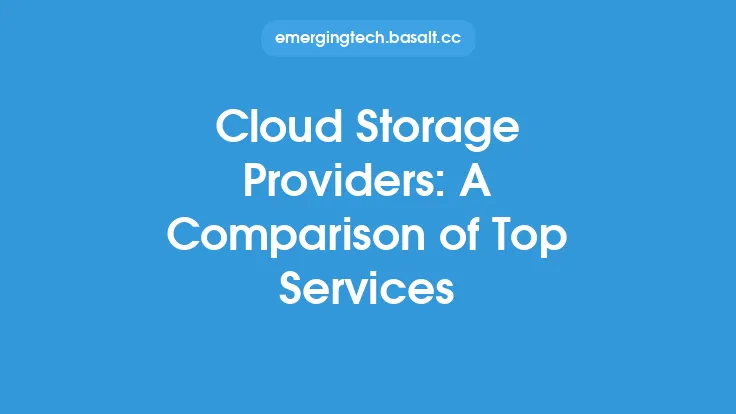Cloud storage has become an essential component of modern computing, allowing users to store and access data from anywhere, at any time. However, not all cloud storage is created equal, and there are several types of cloud storage that cater to different needs and use cases. In this article, we will delve into the three primary types of cloud storage: object, file, and block storage.
Introduction to Object Storage
Object storage is a type of cloud storage that stores data as objects, which are typically large files or blobs of data. Each object is assigned a unique identifier, and metadata is stored along with the object to provide additional context. Object storage is designed for large amounts of unstructured data, such as videos, images, and documents. It is often used for archiving, backup, and disaster recovery purposes. Object storage is highly scalable, and data can be easily retrieved using the unique identifier. Examples of object storage include Amazon S3, Microsoft Azure Blob Storage, and Google Cloud Storage.
File Storage in the Cloud
File storage, on the other hand, is a type of cloud storage that stores data as files and folders, similar to traditional on-premises file systems. File storage is designed for structured data, such as documents, spreadsheets, and presentations. It is often used for collaboration, file sharing, and data synchronization. File storage provides a hierarchical structure, making it easy to navigate and manage files. Examples of file storage include Dropbox, Google Drive, and Microsoft OneDrive. File storage is ideal for use cases where data needs to be accessed and modified frequently.
Block Storage: A Deep Dive
Block storage is a type of cloud storage that stores data as blocks, which are typically 512 bytes or 4KB in size. Each block is assigned a unique identifier, and data is stored in a flat namespace. Block storage is designed for high-performance applications, such as databases, virtual machines, and containerized applications. It provides low-latency and high-throughput access to data, making it ideal for use cases that require fast data access. Block storage is often used for primary storage, where data is frequently accessed and modified. Examples of block storage include Amazon EBS, Microsoft Azure Disk Storage, and Google Cloud Persistent Disk.
Key Differences Between Object, File, and Block Storage
While all three types of cloud storage provide a way to store and access data, there are key differences between them. Object storage is designed for large amounts of unstructured data, while file storage is designed for structured data. Block storage, on the other hand, is designed for high-performance applications. Object storage is highly scalable, but may have higher latency than file or block storage. File storage provides a hierarchical structure, making it easy to navigate and manage files. Block storage provides low-latency and high-throughput access to data, making it ideal for use cases that require fast data access.
Use Cases for Each Type of Cloud Storage
Each type of cloud storage has its own set of use cases. Object storage is ideal for archiving, backup, and disaster recovery purposes. It is also used for storing large amounts of unstructured data, such as videos, images, and documents. File storage is ideal for collaboration, file sharing, and data synchronization. It is also used for storing structured data, such as documents, spreadsheets, and presentations. Block storage is ideal for high-performance applications, such as databases, virtual machines, and containerized applications. It is also used for primary storage, where data is frequently accessed and modified.
Choosing the Right Type of Cloud Storage
Choosing the right type of cloud storage depends on the specific needs and use cases of the organization. Object storage is ideal for large amounts of unstructured data, while file storage is ideal for structured data. Block storage is ideal for high-performance applications. Organizations should consider factors such as scalability, performance, and data structure when choosing the right type of cloud storage. They should also consider the cost and complexity of each type of storage, as well as the level of support and maintenance required.
Conclusion
In conclusion, cloud storage is a complex and multifaceted technology that provides a range of benefits and advantages. The three primary types of cloud storage - object, file, and block storage - each have their own strengths and weaknesses, and are designed for different use cases and applications. By understanding the differences between these types of storage, organizations can make informed decisions about which type of storage to use, and how to use it to meet their specific needs and goals. Whether it's archiving, backup, and disaster recovery, collaboration, file sharing, and data synchronization, or high-performance applications, cloud storage has the potential to revolutionize the way we store and access data.





